Carroll Reed was a pioneer in the American skiing world, shaping not only the sport but also the retail landscape for ski enthusiasts in New England. Born in 1905, Reed’s early life didn’t indicate that he would become a central figure in skiing culture, but an accident while skiing in the 1930s would set him on a different path. After breaking his back in a serious fall, he dedicated himself to improving the safety and accessibility of skiing, founding the Eastern Slope Ski School in 1936. This ski school was pivotal in teaching proper technique and promoting the sport in the Mt. Washington Valley of New Hampshire, an area that eventually became a thriving hub for skiing thanks to Reed’s efforts.
However, Carroll Reed’s influence extended far beyond ski instruction. In the late 1930s, he opened his first ski shop in Jackson, New Hampshire, which sold equipment and ski apparel. As his reputation grew, so did his business, leading to the creation of the iconic Carroll Reed Ski Shops. These stores became synonymous with high-quality, stylish outerwear that catered to the needs of both serious skiers and fashionable New Englanders. The brand’s growth mirrored the increasing popularity of skiing in the U.S., and Reed became a household name for anyone who loved the slopes.
Over the decades, Carroll Reed stores expanded to over 50 locations and became a staple in preppy, outdoor fashion. The brand underwent several changes in ownership after Reed sold it in 1969, but the stores remained a beloved part of the ski and fashion community until their closure in 1996. Today, vintage Carroll Reed items are highly sought after for their quality craftsmanship and timeless style, offering a nostalgic connection to a golden era of American skiing and outdoor apparel.
90s Carroll Reed Lookbook
How to tell if Carroll Reed is vintage from the logo
Carroll Reed, a brand known for its ski and outerwear, has seen several changes in its logo throughout the decades. These changes offer helpful clues for identifying vintage items. By paying attention to the font, imagery, and structure of the logos, you can determine when a particular piece was produced. Below is a guide to the different Carroll Reed logos over the years, based on the attached images.
1970s to 2000s Carroll Reed logo
- This logo features a skier in action, aligning with Carroll Reed’s ski shop heritage.
- The “Carroll Reed” text is bold, angular, and capitalized, showing a vintage aesthetic commonly used in the 70s and beyond.
- The image of the skier is detailed, suggesting its use in earlier promotional or branding materials when more intricate designs were in vogue.

1970s to 2000s Carroll Reed logo
1980s to 2000s Carroll Reed logo
- This logo shows the brand name “Carroll Reed” in a rounded serif font, a departure from the bold angular fonts of earlier decades.
- The font style is simpler and more elegant, focusing on the brand name without accompanying imagery.
- The overall design is straightforward, reflecting the late 20th-century trend toward minimalist branding.

1980s to 2000s Carroll Reed logo
1990s Carroll Reed logo (1)
- This iteration of the Carroll Reed logo features cursive text, giving the logo a more sophisticated and refined feel.
- The “Carroll” text is stylized with flowing curves, making it stand out compared to earlier versions.
- This was likely used in the 1990s to appeal to a higher-end market with its more luxurious appearance.

1990s Carroll Reed logo 1
1990s Carroll Reed logo (2)
- This logo showcases the brand’s evolution with an addition of a leafy motif above the brand name.
- The “Carroll Reed” text is in a bold, classic serif font, reflecting a shift towards a more polished and mature identity.
- The use of the registered trademark symbol next to the name adds a sense of established professionalism.

1990s Carroll Reed logo 2
How to tell if Carroll Reed is vintage from the tags
Carroll Reed, a brand known for its classic and outdoor wear, has seen a distinctive evolution in its tags over the decades. Each era is marked by unique design elements that reflect the trends and styles of the time, as well as the brand’s growing identity. Below is a guide to help you determine whether a Carroll Reed item is vintage based on its tag, with specific references to tags from the 1970s, 1980s, 1990s, and 2000s.
Need help with vintage tags or labels? Submit a picture on our vintage tag identification page, and we’ll assist you!
1970s vintage Carroll Reed tags
- Features the “Carroll Reed Ski Shops” branding, emphasizing its roots in outdoor and ski apparel.
- Square or rectangular tags with serif fonts, often accompanied by illustrations of skis or ski-related imagery.
- Tags often include “New Hampshire,” reflecting the brand’s original location.
- Some tags from this era include vibrant embroidered designs, such as the “Carroll Reed of New England” tag, which often features bright red and green stitching.

1970s Carroll Reed tags
1980s vintage Carroll Reed tags
- The branding remains consistent with the “Ski Shops” and “New Hampshire” mentions, emphasizing the outdoor focus.
- Tags often feature more elaborate illustrations, such as ski-related graphics and fine detailing, like skiers or skiing equipment.
- Font styles transition slightly, with bold serif letters becoming a staple of the design.
- Tags might also introduce additional wording like “Since 1936,” marking the brand’s long heritage.

1980s Carroll Reed tags
1990s vintage Carroll Reed tags
- Tags feature a sleeker, more modern look while retaining the Carroll Reed logo and font style.
- Bold serif lettering remains consistent, but the tags take on more minimalistic elements, with some only showing the brand name.
- Tags with color contrasts, such as white background with bold lettering, become more common.
- Some tags include the classic “Carroll Reed” logo without any additional descriptors like “Ski Shops” or locations, reflecting a broader brand appeal.

1990s Carroll Reed tags
2000s vintage Carroll Reed tags
- Tags from the 2000s feature modern materials and a variety of colors, moving away from the previous decade’s minimalism.
- Font styles remain bold but start to incorporate more decorative elements, such as flourishes and additional logos.
- Tags often emphasize “Since 1936,” reinforcing the brand’s long history, while the design remains elegant with embroidered elements.
- Loop tags or more durable materials appear, indicating a focus on both functionality and aesthetics in the branding.

2000s Carroll Reed tags





Thank you for the great post. I just bookmarked it. If you like ???????, check out our site here:
https://b2gmax.com
Thanks for sharing. I read many of your blog posts, cool, your blog is very good.